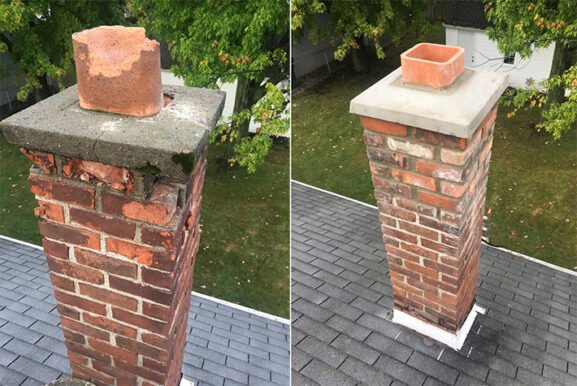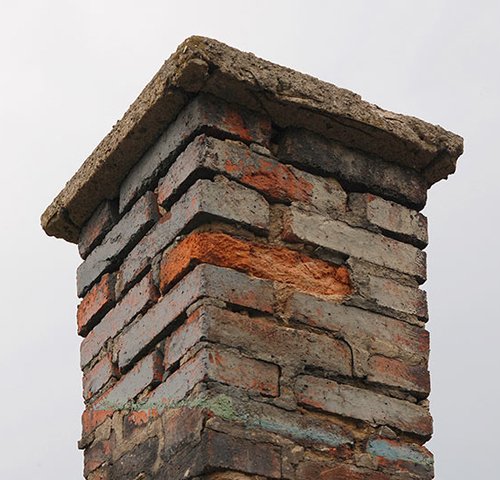Why Timely Concrete Chimney Crown Repair Protects Your Entire Chimney System
Key Takeaways
- Cracks or deterioration in your concrete chimney crown can lead to serious water damage if left untreated
- Concrete crown repair helps prevent internal chimney decay and costly structural issues
- Seasonal weather changes in regions like New Jersey and New York accelerate concrete wear and tear
- Addressing minor damage early helps extend the life of your entire chimney system
Understanding the Role of a Concrete Chimney Crown
A concrete chimney crown is the topmost barrier that shields the chimney from the elements. It covers the flue tiles and masonry walls, diverting rainwater and snow away from the chimney structure. While it may seem like a minor part of the system, the crown plays a critical role in long-term chimney performance.
When this concrete surface starts to crack or erode, moisture can seep in. Over time, that moisture can lead to rusting chimney liners, damaged bricks, and even leaks inside the home. Unfortunately, many homeowners overlook the condition of their crown until visible damage or water stains appear.
What Causes a Concrete Chimney Crown to Fail
Concrete chimney crowns are constantly exposed to harsh environmental stressors. In regions with fluctuating temperatures—especially the freeze-thaw cycles common in the Northeast—cracks form as water freezes inside tiny pores in the concrete. Over time, the damage widens and deepens.
Poor construction practices can also contribute to early failure. A crown that’s too thin, lacks a proper drip edge, or was poured without reinforcement may break down much faster. Even small imperfections during installation can compromise the crown’s effectiveness.
Tree debris, acid rain, or animals nesting on the chimney top can also introduce moisture or physical stress. Combined, these factors gradually degrade the surface and allow water to infiltrate the brickwork beneath.
Signs You Need Chimney Crown Repair
Homeowners should routinely inspect their chimney crown or have a professional do so, especially after winter. Here are key signs that indicate concrete crown repair may be needed:
- Visible cracks or missing pieces on the top surface
- Staining on the chimney exterior (usually white efflorescence or rust)
- Leaks inside the firebox after rain
- Loose or deteriorating mortar joints near the top of the chimney
- Moss or plant growth on the crown, which signals water retention
These signs may seem small, but they are early warnings of potential larger failures. A timely repair helps prevent escalating repair bills and irreversible chimney damage.
How Experts Repair a Concrete Chimney Crown
Repairing a concrete chimney crown involves more than patching a few cracks. Professionals follow a detailed process to restore its function and durability.
The process typically starts with a full inspection. If the crown is structurally sound and only has surface cracks, a flexible crown sealant may be applied. This waterproofs the crown and seals small cracks to prevent further water intrusion.
If there is more serious damage, partial or full crown resurfacing may be required. This involves cleaning off loose material, applying a bonding agent, and adding a new concrete layer shaped for proper runoff.
In severe cases where the crown is crumbling or improperly constructed, a full crown rebuild might be necessary. The contractor will remove the old concrete, install proper reinforcement, and pour a new crown with overhanging drip edges to shed water effectively.
For added longevity, professionals may also coat the new crown with a breathable water-repellent finish. This protects the crown without sealing in moisture, which could otherwise lead to internal cracking during temperature changes.
Why Crown Repair is a Cost-Saving Move
While some homeowners delay chimney crown repairs to save money, this often leads to greater costs down the road. A cracked crown may allow water to saturate the chimney’s brick and mortar. Over time, that can cause interior water leaks, spalling brick, damaged flashing, or even chimney collapse in extreme cases.
Catching the problem early keeps repairs minimal and more affordable. A crack that costs a few hundred dollars to seal today could lead to thousands in structural and interior repairs later. According to the Chimney Safety Institute of America, properly constructed and maintained crowns are key to reducing chimney maintenance costs over time.
Also, when a chimney system becomes water-damaged, it may no longer meet code or safety standards. That could pose risks when selling your home or using the fireplace during colder months.
How Climate Conditions Impact Crown Durability
In regions like New York and New Jersey, the combination of snow, sleet, rain, and coastal humidity makes chimney crowns especially vulnerable. Winters often include repeated freeze-thaw cycles that expand cracks and force water deeper into the crown’s surface.
UV rays during the summer can also weaken the concrete by drying it out and making it brittle. When precipitation returns in fall and winter, already stressed crowns are more prone to failure.
If your home is near the coast or surrounded by trees, environmental conditions may add further wear. Salt in coastal air and acidic rain from urban pollution both accelerate concrete corrosion. Debris from trees can block drainage and trap moisture on the crown’s surface.
Understanding these regional risks helps homeowners appreciate why timely inspection and repairs are essential.
Choosing the Right Repair Professional Matters
While chimney crown repair might sound straightforward, it requires experience with both masonry and chimney-specific construction techniques. A general handyman may not recognize signs of deeper issues or may use inappropriate materials like standard mortar, which isn’t ideal for chimney crowns.
Certified chimney professionals understand how to build crowns with proper slope, drip edges, and sealants designed to withstand high heat and constant exposure to the elements. Many also provide warranties for their work, offering peace of mind.
Look for contractors with certification from respected organizations like the Chimney Safety Institute of America (CSIA) or the National Chimney Sweep Guild (NCSG). These credentials demonstrate a commitment to proper training and ethical service standards.
Preventative Maintenance Keeps Crowns in Top Shape
Repairing a damaged crown is important, but preventing damage in the first place is even better. Annual chimney inspections help catch early signs of wear before they turn into costly repairs.
Many homeowners also choose to apply water-repellent coatings to newly repaired or rebuilt crowns. These treatments allow moisture to escape from inside the concrete while blocking new water from entering. When applied by professionals, they extend the lifespan of the crown significantly.
You might also consider installing a chimney cap if one isn’t present. This inexpensive addition protects both the crown and flue from rain, animals, and debris while improving airflow.
Safeguarding Your Chimney Starts at the Top
The condition of your chimney crown isn’t just a cosmetic issue—it directly affects the performance, safety, and longevity of the entire chimney system. Homeowners who stay proactive with maintenance and repair avoid the stress and expense of major damage down the line.
Whether it’s a minor crack or a full crown rebuild, taking action now can help you avoid chimney leaks, structural issues, and fireplace downtime in the future. Be sure to choose a qualified chimney expert for inspections and repairs, especially in weather-intense regions where chimney damage is more likely to occur.

